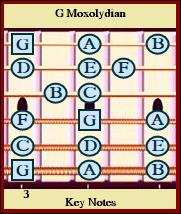G Mixolydian Mode Guitar Scale
G Mixolydian Mode Guitar Scale
The G Mixolydian Mode Guitar Scale is the 5th degree of C Ionian (Major) Scale. The Mixolydian Mode has a Major 3rd Interval making it a major sounding mode. The only difference in sound between the Ionian (Major) and the Mixolydian Mode. The last note in the Major Scale the 7th (Major 7th interval) is moved down a half step to a b7 (Minor 7th Interval).
If you are doing ear training the Mixolydian Mode can easily be mistaken for the Ionian Major. Proper training helps to hear the subtle difference moving that last note down a half step. The first six notes played are same interval notes between the two scales.
Another big confusion with modes in the beginning. C Ionian (Major) and G Mixolydian are of the same key. Parallel modes are two different scales with the same tonal center, G Ionian (Major) and G Mixolydian are now two different keys. Key Signature G Major 1 sharp and D Major 2 sharps with the 1 raised 1/2 step note.
The scale diagrams below display 2 Octave fingering played starting at the 3rd Fret. They show the Interval, Note, and Finger Placement of G Mixolydian Mode. This is a quick and easy option to view with Guitar Analyzer Software. Physical practice playing these fingerings straight up ascending and down descending. Helps beginners develop their auditory intelligence along with physical dexterity muscle memory.
The next level of practice is sequences which is a repeating pattern of notes. Here is a triplets style pattern (121, 232, 343, and so on) with each group of 2 notes going up the scale. The next ascending triplet sequence is up 3 notes (123, 234, 345 and so on). Repeat the process going in a backward sequence descending from the highest note.




G Mixolydian Mode Guitar Scale
The G Mixolydian Mode Guitar Scale is the 5th degree of C Ionian (Major) Scale. The Mixolydian Mode has a Major 3rd Interval making it a major sounding mode. The only difference in sound between the Ionian (Major) and the Mixolydian Mode. The last note in the Major Scale the 7th (Major 7th interval) is moved down a half step to a b7 (Minor 7th Interval).
If you are doing ear training the Mixolydian Mode can easily be mistaken for the Ionian Major. Proper training helps to hear the subtle difference moving that last note down a half step. The first six notes played are same interval notes between the two scales.
Another big confusion with modes in the beginning. C Ionian (Major) and G Mixolydian are of the same key. Parallel modes are two different scales with the same tonal center, G Ionian (Major) and G Mixolydian are now two different keys. Key Signature G Major 1 sharp and D Major 2 sharps with the 1 raised 1/2 step note.
The scale diagrams below display 2 Octave fingering played starting at the 3rd Fret. They show the Interval, Note, and Finger Placement of G Mixolydian Mode. This is a quick and easy option to view with Guitar Analyzer Software. Physical practice playing these fingerings straight up ascending and down descending. Helps beginners develop their auditory intelligence along with physical dexterity muscle memory.
The next level of practice is sequences which is a repeating pattern of notes. Here is a triplets style pattern (121, 232, 343, and so on) with each group of 2 notes going up the scale. The next ascending triplet sequence is up 3 notes (123, 234, 345 and so on). Repeat the process going in a backward sequence descending from the highest note.




